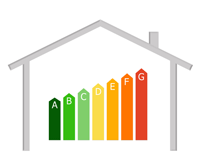Many homeowners these days are unfamiliar with the whole-house approach to energy savings. Yet, it’s the best way to make sure your home is delivering optimal heating and cooling at the lowest price.
Both passive and active energy components work together as a system to cool and heat your home. In the first case, the HV AC system transfers both solar and internally generated heat outdoors; in the second, the system and/or captured solar heat add warmth. Besides air leakage, many other factors critically affect the system’s efficiency.
AC system transfers both solar and internally generated heat outdoors; in the second, the system and/or captured solar heat add warmth. Besides air leakage, many other factors critically affect the system’s efficiency.
By taking a whole-house approach that better controls the factors causing the initial discomfort, you help minimize demands put on heating and cooling components.
To increase your energy savings, consider the following suggestions:
- In drafty areas, apply weatherstripping or caulk in small cracks, and use foam sealant to seal larger gaps.
- Install low-emissivity (low-E) or storm windows. Look for the Energy Star.
- Have your ductwork professionally evaluated for leakage. Seal and then insulate as necessary.
- Upgrade attic insulation to the recommended level for Yuma’s climate zone.
- Turn off unused lights and electronics, preferably at the power strips.
- Unplug rarely used appliances.
- Upgrade your HVAC system or have the existing one professionally serviced.
- Install a programmable thermostat.
- Change air filters frequently. Check them at least once a month.
- Upgrade to more energy-efficient appliances.
- Insulate your old water heater, or upgrade to a new high-efficency model (which likely will come well insulated).
- Set its thermostat at 120 degrees.
- Take short showers.
- Only operate dishwashers and washing machines when full, and air-dry items when possible.
- Clean and/or unblock dryer vents and registers.
- In summertime, use ceiling fans to create wind chill, and then adjust your air conditioner’s temperature accordingly.
- Use only LED or compact fluorescent bulbs.
- In summertime, use drapes to block solar heat.
- During winter, open them up and let solar heat into your home. Close them when it gets dark to add another layer of insulation.
- Plant deciduous landscaping for summer shade and winter sunlight.
Note that it’s important to finish sealing projects before adding insulation; however, sealing your home too tightly can reduce indoor air quality. There should be a controlled way for air to get in and out.
If you’d like help with a home energy audit, or for any questions you have regarding a whole-house approach to energy savings, please contact us at Hansberger Refrigeration & Electric Co. We’ve been serving the Yuma area since 1952.
Our goal is to help educate our customers in Yuma, Arizona about energy and home comfort issues (specific to HVAC systems). For more information about energy savings and other HVAC topics, download our free Home Comfort Resource guide.
Image courtesy of Shutterstock

